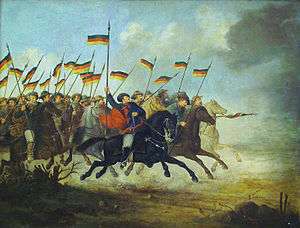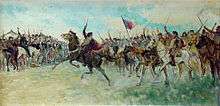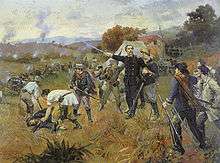Ragamuffin War
| Ragamuffin War | |||||||
|---|---|---|---|---|---|---|---|
 Charge of the Cavalry by Guilherme Litran (Júlio de Castilhos Museum, Porto Alegre), depicting the Riograndense army. It is noteworthy that the flag is similar to the present Flag of Germany | |||||||
| |||||||
| Belligerents | |||||||
| |||||||
| Commanders and leaders | |||||||
| Strength | |||||||
| 14,000 soldiers[1] | 22,000 soldiers[1] | ||||||
| Casualties and losses | |||||||
| 20,000 dead[1] | |||||||
The Ragamuffin War (Portuguese: Guerra dos Farrapos or, more commonly Revolução Farroupilha) was a Republican uprising that began in southern Brazil, in the state of Rio Grande do Sul in 1835. The rebels, led by generals Bento Gonçalves da Silva and Antônio de Sousa Neto with the support of the Italian fighter Giuseppe Garibaldi, surrendered to imperial forces in 1845.[2]
It is considered the longest and second bloodiest of the failed wars of secession in the Brazilian Empire, after the Cabanagem Revolt.
History
The start of the war
The uprising is believed to have begun due to the difference between the economy of Rio Grande do Sul and the rest of the country. Unlike the other states, the state economy focused in the internal market rather than exporting commodities. The state's main product, charque (dried and salted beef), suffered badly from competition from charque imported from Uruguay and Argentina, which had free access to Brazilian markets while the gauchos (as residents of Rio Grande do Sul are called) were charged high taxes inside Brazil.
In 1835, Antônio Rodrigues Fernandes Braga was nominated president of Rio Grande do Sul and at first his appointment pleased the liberal farmers, but that soon changed. In his first day in the office, he accused many farmers of being separatists.
On 20 September 1835, General Bento Gonçalves captured the capital, Porto Alegre, beginning an uprising against the perceived unfair trade reinforced by the state government. The state president fled to the city of Rio Grande, 200 km (120 mi) to the south. In Porto Alegre, the rebels, also known as "ragamuffins" (farrapos) after the fringed leather worn by the gauchos,[2] elected Marciano Pereira Ribeiro their new president.
Responding to the situation and further upsetting the rebels, the Brazilian regent, Diogo Feijó, appointed a new state president, who was forced to take office in exile in Rio Grande.
Declared independence


Pushing to consolidate their power, Antônio de Souza Netto declared the independence of the Riograndense or Piratini Republic on 11 September 1836, with Bento Gonçalves as president nominee. However, Gonçalves was arrested and jailed by imperial forces until he escaped in 1837, returning to the province and bringing the revolution to a head. Nonetheless, Porto Alegre was recaptured by the empire and the rebels never managed to regain it.
The Italian revolutionary Giuseppe Garibaldi joined the rebels in 1836. With his help, the revolution spread north through Santa Catarina, which adjoined Rio Grande do Sul. One of the main cities of Santa Catarina, Laguna, was taken by the rebels but fell back into imperial hands after four months. It was in this struggle that Garibaldi gained his first military experience and got on the road leading to his becoming the famed military leader of the Unification of Italy.[3]
Resultant peace
The rebels refused an offer of amnesty in 1840, although it was clear that they had no chances of winning. In 1842, they issued a republican constitution as a last attempt to maintain power. The same year saw General Lima e Silva take command of Imperial forces in the area, and try to negotiate a settlement.
On 1 March 1845, the peace negotiations led by Lima e Silva and Antônio Vicente da Fontoura concluded with the signing of the Ponche Verde Treaty between the two sides, in Dom Pedrito. The treaty offered the rebels a full amnesty, full incorporation into the imperial army and the choice of the next provincial president. All the debts of the Riograndense Republic were paid off by the Empire and a tariff of 25% was introduced on imported charque. The Treaty did not state clearly whether the Riograndense and Juliana republics remained independent, but they remained in the Empire and are now two states of the Federative Republic of Brazil, Rio Grande do Sul and Santa Catarina respectively.
As a goodwill gesture, the rebels chose Lima e Silva as the next provincial president.
Popular culture
- Anita e Garibaldi, a 2013 Brazilian film, follows the arrival of Giuseppe Garibaldi in Brazil, his meeting with Anita Garibaldi and the human and military learning with Luigi Rossetti during the Ragamuffin War.[4]
See also
References
- 1 2 3 https://books.google.com/books?id=s50JnG7BzLAC&printsec=frontcover&hl=es#v=onepage&q&f=false
- 1 2 Loveman, Brian (1999). For La Patria: Politics and the Armed Forces in Latin America (illustrated ed.). Rowman & Littlefield. p. 43. ISBN 978-0-8420-2773-1.
- ↑ Trevelyan, George Macaulay (1907-01-01). Garibaldi's defence of the Roman Republic. London, New York [etc.] : Longmans, Green and Co.
- ↑ http://www.ancine.gov.br/brasil-nas-telas/anita-e-garibaldi
External links
| Wikimedia Commons has media related to War of Tatters. |
.svg.png)